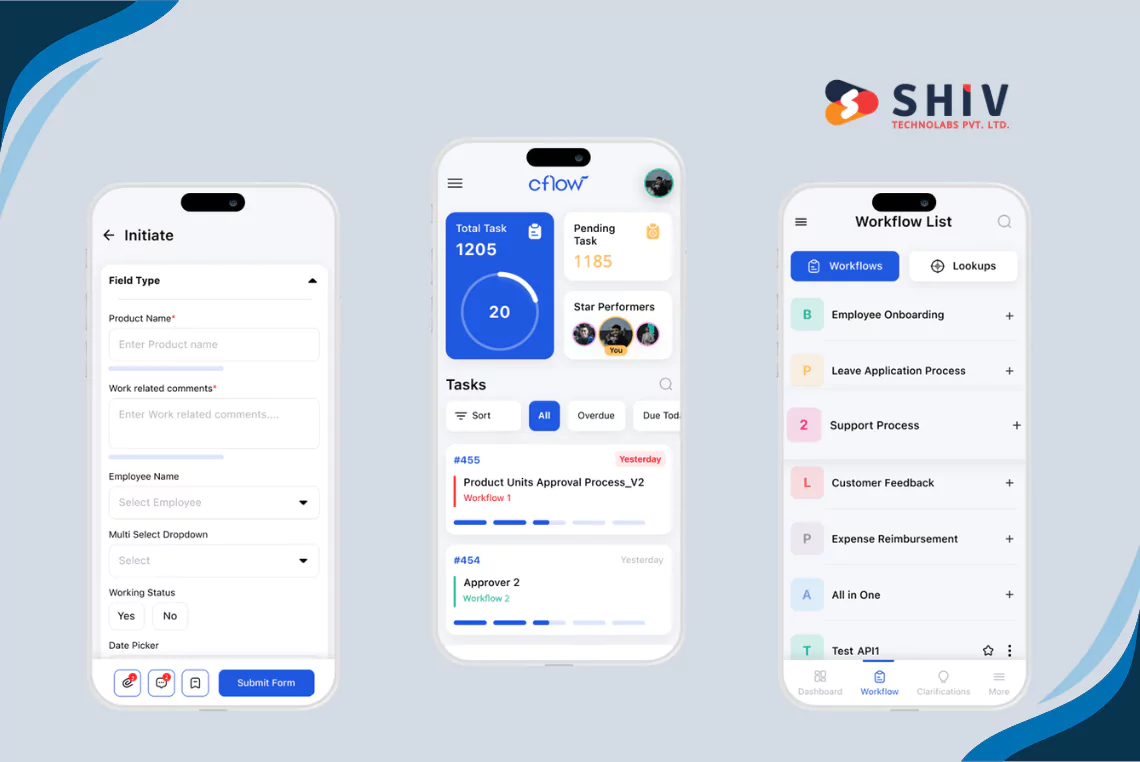Table of Contents
React Native remains a cornerstone of cross-platform mobile app development, allowing businesses to target multiple platforms while saving development time and costs. As we look toward 2024, a set of emerging trends and technologies promises to redefine the React Native ecosystem. Here are the top 10 trends that developers and businesses should watch closely.
1. Serverless Architecture Adoption

Serverless architecture is becoming a core element in modern mobile app development, allowing developers to sidestep the complexities of server management. By removing the burden of managing the infrastructure, React Native developers can focus entirely on building features and refining user experiences. Serverless platforms such as AWS Lambda, Firebase Cloud Functions, and Google Cloud Functions have simplified backend processes, enabling React Native developers to build scalable, reliable apps that handle large volumes of user traffic without compromising performance.
One of the major benefits of serverless architecture is the pay-as-you-go pricing model, where developers only pay for the computing resources they use, thus reducing operational costs. This model suits startups and businesses working with limited budgets who want to avoid the high costs of traditional server management. By leveraging cloud services for tasks like user authentication, storage, and database management, developers can roll out app features more quickly and with less overhead.
Looking ahead, serverless architecture will continue to gain momentum in the React Native space, as businesses aim for faster time-to-market and scalability.
2. Machine Learning and Artificial Intelligence (AI)
Machine learning (ML) and artificial intelligence (AI) are key drivers behind personalized user experiences in mobile apps. React Native, with its vast ecosystem and compatibility with various libraries, makes it easier for developers to integrate AI and ML features into cross-platform apps.
Take, for instance, AI-powered chatbots that handle customer service queries or virtual assistants embedded within mobile apps to provide personalized recommendations. These features are becoming a must-have in modern applications. Additionally, image recognition and speech processing, powered by machine learning models, are elevating user interactions, making apps more intelligent and adaptive to user behavior.
In 2024, as the demand for real-time analytics and customized experiences grows, developers will focus on using libraries such as TensorFlow.js and Core ML to build smart, intuitive React Native apps. These tools allow developers to deploy machine learning models directly within mobile apps, without relying on heavy server-side computation, resulting in more efficient data processing and enhanced app responsiveness.
3. React Native Fabric: The Future of Performance

React Native Fabric is a major under-the-hood overhaul that promises to transform how apps are rendered, boosting both flexibility and performance. In the traditional React Native architecture, communication between JavaScript and native modules was a challenge, often resulting in delays or less-than-optimal performance. Fabric solves this by introducing an asynchronous rendering engine that provides developers with more control over UI rendering processes.
One of the biggest advantages Fabric brings is the ability to reduce the lag in rendering complex UI components, making apps smoother and more responsive. For instance, apps requiring real-time data updates or those with dynamic content, like video streaming services or financial trading platforms, will benefit greatly from Fabric’s enhanced rendering capabilities.
By implementing React Native Fabric, developers can also improve the overall user experience, offering more fluid interactions and ensuring that the app maintains high performance, even under heavy loads.
4. Concurrent Rendering for Dynamic Apps
Concurrent rendering, introduced in React 18, is expected to be a game changer for React Native apps in 2024. This feature allows the app to prioritize which components to render, meaning tasks that are more critical can be processed first. Concurrent rendering makes the app more responsive, as less important updates are deferred until the app has idle time.
For developers building React Native apps that require complex user interactions, such as messaging apps, social networks, or video conferencing platforms, concurrent rendering ensures that the UI doesn’t freeze or lag when users perform multiple actions simultaneously. This feature improves the overall app experience, providing smoother scrolling, quicker interactions, and the ability to handle more complex user tasks without interruptions.
In 2024, concurrent rendering will be essential for building high-performance apps that must handle multiple user interactions without sacrificing responsiveness.
5. AR and VR Integration in React Native
Augmented reality (AR) and virtual reality (VR) are no longer just buzzwords confined to the gaming industry. Today, AR and VR are expanding across various industries, including education, healthcare, and retail, offering new ways to engage users and transform traditional business models.
React Native’s growing support for AR and VR, through libraries such as ViroReact, allows developers to create immersive experiences without needing platform-specific coding skills. For example, AR-based virtual try-ons in e-commerce apps, VR-based learning simulations in education, or even AR-powered training for healthcare professionals are some of the ways these technologies are being integrated into mobile apps.
In 2024, the integration of AR and VR in React Native apps will see rapid growth, as businesses seek to provide immersive experiences that captivate and retain their users.
6. Super Apps and Multifunctional Applications
Super apps are multifunctional applications that offer multiple services within a single platform. Popular in regions like Asia, with apps like WeChat and Gojek leading the way, super apps combine messaging, payments, social networking, e-commerce, and more into a single user interface.
React Native’s versatility makes it an ideal framework for building super apps, as it allows developers to create complex, feature-rich applications that run on multiple platforms from a single codebase. These apps require robust development frameworks that can handle a variety of functions without compromising performance, and React Native delivers just that.
In 2024, super apps will likely continue to grow, especially in regions where mobile users demand all-in-one solutions. React Native will be instrumental in enabling businesses to offer these all-encompassing services to their user base.
7. Ongoing Focus on Performance Optimization
Mobile users demand apps that are fast, responsive, and lightweight. As mobile hardware continues to advance, developers are expected to take full advantage of the available resources to improve app performance. In 2024, React Native will see a continued emphasis on performance tuning and resource management.
React Native developers are already leveraging tools like Hermes, a JavaScript engine optimized for React Native, to improve performance on Android devices. Hermes helps apps load faster and reduces memory consumption, providing a better user experience, especially for applications with large datasets or complex animations.
Additionally, developers are focusing on optimizing performance for iOS devices, ensuring that React Native apps maintain parity across platforms. Expect to see more tools and techniques aimed at making React Native apps faster and more responsive in 2024.
8. Advanced Security Measures
Security has always been a critical concern for mobile app developers, especially when dealing with sensitive data such as payment details or personal information. React Native developers are increasingly integrating advanced security features, such as biometric authentication, multi-factor authentication (MFA), and end-to-end encryption, to protect their apps from cyber threats.
In 2024, security frameworks like Firebase Authentication and AppAuth will continue to play an essential role in safeguarding React Native apps. React Native’s flexible architecture allows developers to incorporate these security measures without impacting app performance, ensuring that apps are secure by design.
The growing concern over data privacy and security breaches will drive more businesses to prioritize security in React Native app development, making it a key focus area in 2024.
9. Modular Architecture for Better Scalability
Modular architecture is becoming increasingly important in app development, and React Native is no exception. By breaking down the app into independent, reusable modules, developers can maintain code more easily, update features faster, and scale the app as the business grows.
This trend of modular development will continue to expand in 2024, as businesses look for ways to make their apps more flexible and scalable. React Native’s modular nature allows teams to work on different parts of the app simultaneously, reducing development time and increasing overall efficiency. As the complexity of apps grows, modular architecture will remain a top strategy for React Native developers.
10. The Rise of TypeScript
TypeScript, a superset of JavaScript, has gained significant traction in the React Native community over the past few years. It provides better tooling, earlier error detection, and a more structured codebase, making it easier for developers to build scalable, maintainable applications.
In 2024, the adoption of TypeScript in React Native development will continue to rise, with more projects choosing TypeScript as the default option. This trend is fueled by TypeScript’s ability to provide better code documentation and catch potential errors early in the development process, saving time and reducing bugs.
React Native developers who adopt TypeScript are better equipped to manage large, complex codebases, ensuring that the app remains maintainable as it grows in size and complexity.
# Build Your React Native App with Shiv Technolabs
In the fast-paced world of mobile app development, having a powerful and user-friendly mobile app is essential for business growth. React Native has become a top choice for businesses wanting to build high-performance cross-platform apps. At Shiv Technolabs, a leading React Native app development company, we specialize in creating custom mobile applications that address the unique needs of our clients.
By working with Shiv Technolabs, businesses can benefit from expert developers dedicated to delivering innovative mobile solutions. Whether you are looking to launch your first app or improve an existing one, our React Native app development services are crafted to deliver results that help you stand out in the market.
# Why Hire React Native Developers from Shiv Technolabs?
When you hire React Native developers from Shiv Technolabs, you partner with a team that has extensive experience in building mobile apps for a wide range of industries. Here’s what sets us apart:
- Custom Solutions: We understand that each business has different requirements, and our development process is tailored to deliver an app that aligns with your business goals. Whether you need a simple application or a more complex, feature-rich platform, we deliver the right solution for your needs.
- Cross-Platform Expertise: React Native allows us to develop applications that perform consistently across both iOS and Android, saving you time and money while providing a high-quality app experience for all users.
- Fast and Reliable Development: We follow an efficient development process that focuses on speed without sacrificing quality. From the initial concept to the final product, our team works closely with you at every stage of the project.
- Long-Term Support: After your app is launched, we continue to provide support and maintenance to keep it running smoothly. We offer updates and improvements as needed to keep your app current with the latest mobile trends.
# Choose Shiv Technolabs as Your React Native Partner
At Shiv Technolabs, we take pride in being a trusted React Native app development company. Our team is committed to delivering top-tier React Native app development services that help your business succeed. From building new mobile apps to upgrading existing ones, we are here to guide you through every step of the process, helping you create apps that drive growth and enhance your digital presence.
Conclusion
As we move deeper into 2024, React Native is poised to remain a dominant force in the mobile app development landscape. The framework’s versatility, paired with emerging trends such as serverless computing, machine learning, modular architecture, and AR/VR, will shape the next generation of mobile applications.
By staying at the forefront of these trends, developers can create more powerful, efficient, and secure React Native applications that meet the demands of a rapidly evolving digital world.


















